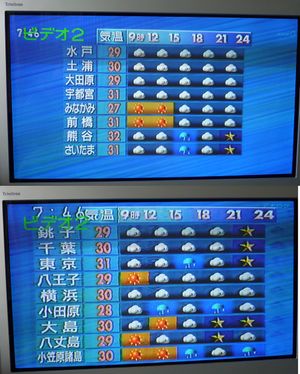تلفزيون رقمي
| قائمة معايير بث التلفزيون الرقمي |
| DVB family (Europe) |
| DVB-S (satellite) |
| DVB-T (terrestrial) |
| DVB-C (cable) |
DVB-H (handheld)
|
| ATSC family (North America) |
| ATSC (terrestrial/cable) |
| ATSC-M/H (mobile/handheld) |
| ISDB family (Japan/Latin America) |
| ISDB-S (satellite) |
| ISDB-T (terrestrial) |
| ISDB-C (cable) |
| SBTVD/ISDB-Tb (Brazil) |
| Chinese Digital Video Broadcasting standards |
| DMB-T/H (terrestrial/handheld) |
| ADTB-T (terrestrial) |
| CMMB (handheld) |
| DMB-T (terrestrial) |
| DMB Family (Korean handheld) |
| T-DMB (terrestrial) |
| S-DMB (satellite) |
| MediaFLO |
| Codecs |
| Video |
| Audio |
| Frequency bands |
| VHF |
| UHF |
| SHF |
التلفزيون الرقمي Digital television (اختصاراً DTV)، هو نقل إشارات التلفزيون، والتي تشمل قنوات الصوت، باستخدام الترميز الرقمي، مقابل التقنية التلفزيونية المبكرة، التلفزيون التناظري، والذي يتم فيه حمل الصورة والصوت بواسطة الإشارات التناظرية. ويعتبر تقدماً مبتكراً يمثل أول تطور ملحوظ في تكنولوجيا التلفزيون منذ اختراع التلفزيون الملون في الخمسينيات.[1] يمكن للتلفزيون الرقمي نقل عدة قنوات على نفس عرض النطاق الذي تشغله قناة واحدة فقط في التلفزيون التناظري،[2] وتوفير الكثير من المزايا التي لا يمكن توافرها في التلفزيون التناظري. الانتقال من البث التناظري إلى البث الرقمي بدأ حوالي عام 2006 في بعض البلدان، والكثير من البلدان الصناعية انتهت حالياً من عملية التغيير، بينما هناك بلدان أخرى تقف في مراحل متفاوتة من تبني هذه التقنية. تم تبني معايير بث مختلفة للتلفزيون الرقمي في مناطق مختلفة من العالم؛ وها هي أكثر المعايير استخداماً:
- بث الڤيديو الرقمي والذي يستخدم تردد متعامد مركز- تقسيم متعدد (OFDM) تشكيل ودعم الإرسال الهرمي. هذا المعيار متبنى في أوروپا، سنغافورة، أستراليا ونيوزيلاندا.
- لجنة المنظومة التلفزيونية المتقدمة (ATSC) تستخدم الحزمة الجانبية اللاوظيفية من المستوى الثامن (8VSB) من أجل البث الأرضي. هذا المعيار متنبى من ستة دول: الولايات المتحدة، كندا، المكسيك، كوريا الجنوبية، جمهورية الدومنيكان، وهندوراس.
- البث الرقمي للخدمات المدمجة (ISDB) هو نظام مخصص لتوفير الاستقبال الجيد للمستقبلات المثبتة والمحمولة أيضاً أو المستقبلات النقالة. هذا المعيار متبنى في اليابان والفلپين.
- بث الأرضي الرقمي متعدد الوسائط (DTMB) والذي يطبق في الصين، وهونگ كونگ ومكاو.[3]
- البث الرقمي المتعدد الوسائ (DMB) هو تكنولوجيا نقل راديوي رقمي طورتها كوريا الجنوبية[4][5][6] كجزء من المشروع القومي لتكنولوجيا المعلومات لإرسال وسائط متعددة مثل التلفزيون والراديو وبث البيانات إلى الأجهزة المحمولة مثل الهواتف المحمولة، الحواسب المحمولة وأنظمة التموضع.
التاريخ
المعلومات التقنية
الصيغ وحزم النطاق
استقبال الإشارة الرقمية
متغيرات الحماية في البث الأرضي الرقمي
| متغيرات النظام (معدلات الحماية) |
كندا [13] | الولايات المتحدة [5] | EBU [9, 12] ITU-mode M3 |
اليابان والبرازيل [36, 37][7] |
|---|---|---|---|---|
| C/N for AWGN Channel | +19.5 dB (16.5 dB[8]) |
+15.19 dB | +19.3 dB | +19.2 dB |
| Co-Channel DTV into Analog TV | +33.8 dB | +34.44 dB | +34 ~ 37 dB | +38 dB |
| Co-Channel Analog TV into DTV | +7.2 dB | +1.81 dB | +4 dB | +4 dB |
| Co-Channel DTV into DTV | +19.5 dB (16.5 dB[8]) |
+15.27 dB | +19 dB | +19 dB |
| Lower Adjacent Channel DTV into Analog TV | −16 dB | −17.43 dB | −5 ~ −11 dB[9] | −6 dB |
| Upper Adjacent Channel DTV into Analog TV | −12 dB | −11.95 dB | −1 ~ −10[9] | −5 dB |
| Lower Adjacent Channel Analog TV into DTV | −48 dB | −47.33 dB | −34 ~ −37 dB[9] | −35 dB |
| Upper Adjacent Channel Analog TV into DTV | −49 dB | −48.71 dB | −38 ~ −36 dB[9] | −37 dB |
| Lower Adjacent Channel DTV into DTV | −27 dB | −28 dB | −30 dB | −28 dB |
| Upper Adjacent Channel DTV into DTV | −27 dB | −26 dB | −30 dB | −29 dB |
التفاعل
بث المقطع-1
خط زمني للنقل
مقارنة التناظري بالرقمي
انظر أيضاً
الهوامش والمصادر
- ^ Kruger, L. G. (2001). Digital Television: An Overview. Hauppauge, New York: Nova Publishers.
- ^ "HDTV Set Top Boxes and Digital TV Broadcast Information". Retrieved 28 June 2014.
- ^ Ong, C. Y., Song, J., Pan, C., & Li, Y.(2010, May). Technology and Standards of Digital Television Terrestrial Multimedia Broadcasting [Topics in Wireless Communications], Communications Magazine, IEEE , 48(5),119-127
- ^ "Korea's Terrestrial DMB: Germany to begin broadcast this May". ZDNet Korea. Retrieved 2010-06-17.
- ^ "picturephoning.com: DMB". Textually.org. Archived from the original on 2010-08-09. Retrieved 2010-06-17.
{{cite web}}: Unknown parameter|deadurl=ignored (|url-status=suggested) (help) - ^ "South Korea : Social Media 답변 내용 : 악어새 - 리포트월드". Reportworld.co.kr. Archived from the original on 2009-08-17. Retrieved 2010-06-17.
{{cite web}}: Unknown parameter|deadurl=ignored (|url-status=suggested) (help) - ^ ISDB-T (6 MHz, 64QAM, R=2/3), Analog TV (M/NTSC).
- ^ أ ب The Canadian parameter, C/(N+I) of noise plus co-channel DTV interface should be 16.5 dB.
- ^ أ ب ت ث Depending on analog TV systems used.
قراءات إضافية
- Hart, Jeffrey A., Television, technology, and competition : HDTV and digital TV in the United States, Western Europe, and Japan, New York : Cambridge University Press, 2004. ISBN 0-521-82624-1
وصلات خارجية
- Overview of Digital Television Development Worldwide Proceedings of the IEEE, VOL. 94, NO. 1, JANUARY 2006 (University of Texas at San Antonio)
- The FCC's U.S. consumer-oriented DTV website
- Digital TV Consumer test reports - UK Government-funded website to support Digital Switchover
- قالب:WikiHow
- قالب:WikiHow
- قالب:WikiHow
